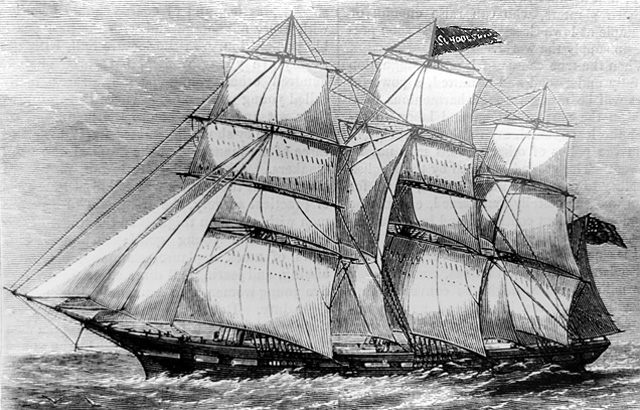|
C. of C. Pipes Bd. of Ed. Aboard School Ship Plan
An April 14, 1867 NYT edit noted that the Chamber of Commerce, pursuant to the 1861 NY law, had set up a three-member committee to serve as trustees for a nautical school: "But the hot stress of the rebellion soon after absorbed the energies of everybody, and the plan is only now revived."
The plan, however, had undergone considerable change. Referring to the trustees Blunt, Walter and Morgan, the editorial observed:
|
These gentlemen propose to secure the aid of the Board of Education in their scheme. . . each [public school] should have its teacher of navigation . . . . Next the Secretary of the Navy is to be appealed for a school-ship . . . Congress is also to be urged to make provision for the support and clothing of these young [student] sailors . . . . we trust the movement by the Chamber of Commerce is the initial step toward reform in every direction.
|
|
XXX
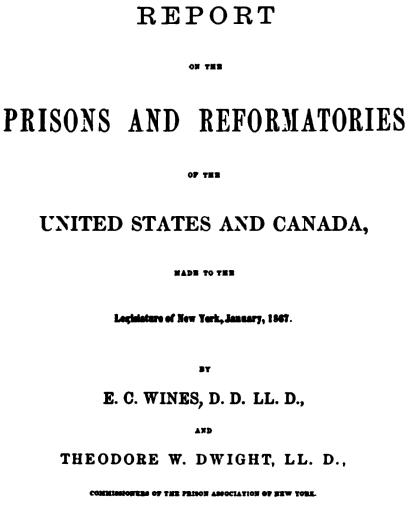
XXX |
|
Above is an image of the cover of the 1867 report by Prison Association of New York leaders Wimes and Dwight in which they strong advocate New York establish a reformatory nautical training ship program. Click image to access a digital copy of the volume on Google Book Search. Use your browser's "back" button to return here.
| | But the editorial hopes of 1866 and 1867 for Chamber-related action advancing the cause of establishing a harbor school seemed raised in vain.
Instead, actions in an entirely different venue took place in 1867-69 that would turn out to have advanced the cause, though they may not have been so recognized at the time.
NY Penal
Reformers
Promote
School
Ship Idea
One of the beginnings in that segment of the SUNY Maritime College "prequel" can be found in the Prison Association of NY Commissioners's Report on the prisons and reformatories of the United States and Canada made to the New York Legislature in January, 1867.
In it, starting on Page 361, the NY Prison Association leaders Enoch Cobb Wines and Theodore W. Dwight made the case for NY establishing a school ship reformatory:
|
XXX
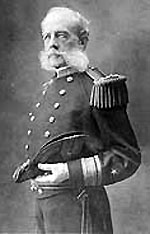
XXX |
|
Stephen Bleecker Luce, who was born on March 25, 1827 in Albany, NY, and died July 28, 1917, spent most of his 76 years of Navy-related activity in the training and continued education of officers. As an Inspector of Training Ships, he had occasion to visit the Mercury with, among others in the inspection team, the father of future President Teddy Roosevelt.
More information on Luce can be accessed through the Naval Historical Center website page by clicking the above image of him that was derived from one on that page. Use your browser's "back" button to return here.
| |
On this subject, Lieutenant Commander S. B. Luce, commandant of midshipmen at Annapolis, an officer of high scientific and general culture, thus expresses himself in the Army and Navy Journal:
|
XXX
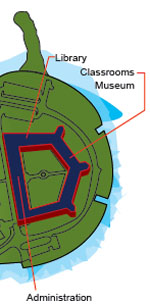
XXX |
|
How ironic that the SUNY Maritime College campus library is named in honor of Admiral Stephen B. Luce, the native NYer who was so open to the idea of a reformatory school ship, yet NY's reform school ship is not included in the nearby campus museum's NY maritime training ships display. Click image to access the library's website. Use your browser's "back" button to return here.
| | "It is officially stated that in 1863, one hundred and thirty-eight of the elder boys in the House of Refuge, on Randall's Island (East River), were permitted to enlist in the army, and have acquitted themselves well.
"Why should they not pass through a reformatory school-ship, and thence into the merchant service, or, indeed, into the navy, and acquit themselves well?"
General Edward L. Molineux, some time since, wrote and published a series of articles of the same purport, in the New York Daily Times.
In the course of his essays, referring to the paper of Commander Luce, he pertinently and forcibly remarks:
"This able officer has struck the key-note . . . .
"it is only common sense to assert that by educating and reforming boys of our seaport towns, by giving them some knowledge of seamanship, habits of discipline and sobriety, it will tend to give our ships a better class of officers and crew, and, in consequence, we shall have fewer disasters from mismanagement, carelessness and ignorance."
We quite agree with these two intelligent representatives of the army and navy of the United States, in the views thus expressed. We think that New York should lose no time in organizing a school-ship, after the example of Massachusetts, and that, having done this, she should add others, as occasion might require. There would he true economy, as well as philanthropy, in the legislation which should give effect to this idea. . . .
|
|
XXX

XXX |
|
The House of Refuge, run by the Society for the Reformation of Juvenile Delinquents, was a reform school that began in Madison Square old barracks in 1825, moved to Bellevue grounds in 1839 and later moved to Randall's Island where the complex illustrated above was erected in 1854. Click for source site, NYC Dept. of Juvenile Justice's web page "Beginnings of the Juvenile Justice System."
| |
This strong recommendation from the Prison Association of New York -- the leading correctional reform organization in the state, founded in 1845 and chartered by the Legislature to report directly to it -- surely carried some weight with legislators. Detailed information about the formation and history of the Prison Association of New York, can be found in The History of the Correctional Association of New York elsewhere on this New York Correction History Society website. The association name-change took place March 1, 1961.
Randall Isle House of Refuge Sought School Ship
Another beginning in this section of the SUNY Maritime College "prequel" can be seen in the Feb. 19, 1867 NYT synopsis of the 42nd annual report of the Society for Reformation of Juvenile Delinquents that operated the House of Refuge on Randall's Island. Under the subtitle "A School-ship called for," the story quoted the report:
|
The idea has long been a favorite one with some of our members that a ship of discipline and instruction would, under proper regulations, form a valuable adjunct to the House of Refuge . . . . This proposition the [House of Refuge] managers press with emphasis upon the attention of the Legislature, deeming it to be one of great importance.
|
The House of Refuge managers in their annual report to the Legislature the following year renewed their school ship request, a proposition whose principle a NYT editorial April 12, 1868 endorsed.
The Legislature that year did not act on the House of Refuge request concerning its acquiring a school ship for Randall's Island but did take a step that led to the Public Charities and Commissioners acquiring Hart Island. The lawmakers acted on a request they received in early January 1868 from the NYC Public Charities and Correction Commissioners in their report on their agency's operations during 1867:
|
XXX
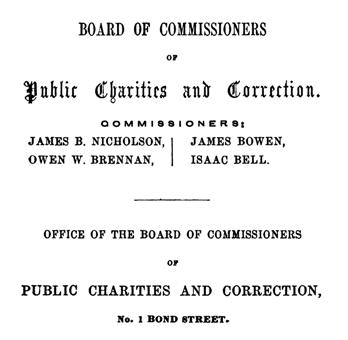
XXX |
|
Above is an image of the unnumbered first page of the 1867 annual report of the NYC Public Charities and Correction Commissioners. Below is an image of the top of Page 4 where the Commissioners' report to the state Legislature begins. The text quoted to the left and below is from Pages 7 and 8 of that report.
|
|
XXX
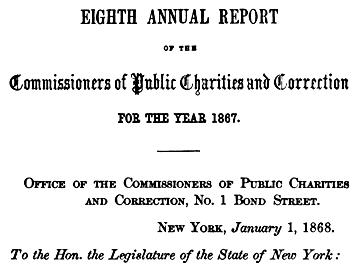
XXX |
|
As stated in the [last Annual] Report [1866] . . . there are 30,000 children in this city growing up in ignorance and idleness. They have no occupation but to beg and learn no art but to steal. Hordes of children are sent out every morning to beg or to pilfer along the piers and bulkheads of the city, to snatch up, unobserved, a few grains of coffee, or handfuls of cotton, or scraps of iron, and their progress from the first act of pilfering to burglary is as regular as the progress of a school boy from class to class.
At the age of 15 the girls are prostitutes, and the boys professed thieves. The brevity of their life, shortened by syphilitic disease, is the only check upon the increase of their numbers. To break up and disperse this portentous evil, can only be accomplished by rescuing the children at a tender age, and before they have entered on criminal or immoral practices.
To this end it is respectfully recommended that the Board may be authorized to establish an Industrial School, separate from the nurseries, to which children of the following classes may be sent, under the warrant of a Police magistrate, there to remain until indentured to some useful pursuit:
- 1st, Children under 12 years of age found begging in the public streets.
- 2d, " '' 14 " " having committed a first offense punishable with imprisonment.
- 3d, Children whose parents represent them as incorrigible and as given to vices and criminal associates.
|
Pages 27 -29 of "The Annual Report of the Commissioners of Public Charities and Correction, New York, for the Year 1868," published in 1869 and printed by Charles Van Benthuysen & Sons, provide some Hart Island acquisition details under the subtitle "Reformatory School:"
|
XXX
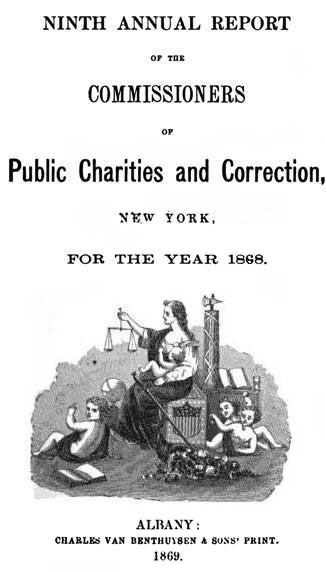
XXX |
|
Above is an image of the cover of the 1868 annual report of the NYC Public Charities and Correction Commissioners. In it they describe the purchase of Hart Island for burial grounds purposes and their plans and actions to use the island for a reformatory.
| |
By an act, passed at the last session of the Legislature, the Commissioners were authorized to buy land for a public cemetery. The most eligible grounds in the vicinity of New York for this purpose were found on Hart's Island, distant about fifteen miles from the city, and separated from the main land by a wide interval of water, and accessible at all seasons of the year.
The island contains about one hundred acres. It was occupied during the rebellion by United States troops, and a portion of it is covered with barracks and officers' quarters.
The Commissioners purchased the island, except three acres reserved as a site for a light-house, with all the buildings, from John Hunter, Esq., for seventy-five thousand dollars. The sum expended by the government for the buildings is understood to have been $210,000. The officers' quarters and several other buildings, twenty-five in number, are in good order and well adapted for the purpose to which the Commissioners have applied them, the foundation of a Reformatory School. Their value is estimated at $40,000.
Besides these buildings, there are many others in a dilapidated condition, but the timber of which is sound and can be used in the construction and repair of other buildings. The value of the timber is estimated, from actual measurement, at $28,600.
The necessity of providing a school, or Reformatory, within the department, for vicious and incorrigible children has long been obvious. Children are daily brought before the magistrates by the police as vagrants and the companions of thieves, or by their parents for evil associations and propensities, and as incorrigible.
With the view, therefore, of providing a Reformatory for vicious children, the Commissioners have fitted up several of the houses on Hart's Island for school rooms and dormitories. About sixty boys have been collected, the most of whom would probably, from their evil associations, have soon been committed to the Penitentiary or House of Refuse for crime. Since their residence on the island they have, with a few exceptions, become tractable and obedient.
They attend school for five hours, and the remainder of the day is devoted to play, or to light labor. They are diligent in their studies and are acquiring habits of industry.
|
Given first the pre-Civil War build-up for a Chamber of Commerce-run non-reform school ship, and then the post-Civil War build-up for a House of Refuge-run reform school ship, how came the Public Charities and Correction Commissioners seemingly out of nowhere in 1869 to (in sports parlance) steal the ball, run with it and score first?
|
XXX

XXX |
|
NYC's docks were a forest of tall masts and rigging during the post Civil War era in which Isaac Bell, James Bowen, James B. Nicholson, and Owen W. Brennan served together as NY Public Charities and Correction Commissioners. Each had a personal connection and feel for NY as the nation's #1 harbor city, THE port of entry and commerce. Illustration entitled The Water Front of a Great Seaport Like New York by Ray Brown from the Project Gutenberg eBook, American Merchant Ships and Sailors by Willis J. Abbot. Click to access. Use browser's "back" to return here.
| |
PC&C 4
Had in
Common
a Personal
Sense of
NYC as
Port City
The backgrounds of those 1869 commissioners -- Isaac Bell, James Bowen, James B. Nicholson, and Owen W. Brennan -- help explain how what happened, happened. The four first came together as the Board of Public Charities and Correction in April 1965 when they formally convened for purposes of organizing it for the next 12 months.
Bell was elected president and Bowen, secretary. Both Bell and Nicholson had been among the four members named to the board by the Comptroller in 1860 under a law eliminating the prior system of a 10-member elected board. The replacement structure, a four-member board, was to be politically balanced, two Democrats, two Republicans.
Bell and Nicholson were the Democrats; Bowen and Brennan, the Republicans.
Though their politics may have differed, each of the four had this in common -- he experienced New York as a port city; that is, his personal perspective of the metropolis had been shaped to some degree, not only on Manhattan Isle's dry land, but also on its surrounding waters:
|
XXX
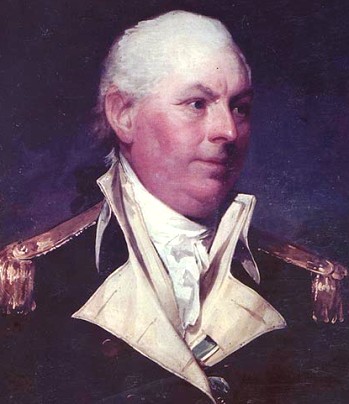
XXX |
|
Above is from Naval Historical Center on-line image of Gilbert Stuart's painting of Commodore John Barry, USN, (1745-1803), widely regarded as the "Father of the U.S. Navy," who was an uncle of PC&C Commissioner James B. Nicholson. Click image to access source page. Use browser's "back" button to return here.
| | - Bowen had been a NYS Harbor Commissioner and later U.S. Emigration Commissioner. As such, he had been much concerned with NY as a port of entry and of commerce.
- Nephew of Commodore ("Father of the U.S. Navy") John Barry, Nicholson had begun his commercial career running a line of steamboats up and down the Hudson River and also later became a State Emigration Commissioner.
- Isaac Bell, extensively involved in Union troop transport from NY to Southern war zones, served as president of the Havre Packet Co. and as vice president of the Old Dominion Steamship Co.
- Brennan had been a New York Harbor Master.
To view these four Public Charities and Correction Commissioners only in terms of their all having had significant NY Port connections would be a distortion. They were multi-faceted individuals whose range of interests and activities were wide and varied.
Nevertheless, that all four would have had particular and personal appreciations of NY as a port city must be considered as a factor in why they stole the march on the Chamber of Commerce and the House of Refuge, each of which had in the Legislature its respective supporters on the issue of authorization to set up a school ship of its own.
Each of PC&C 4 a Wielder of Power
Also to be considered is that these four were individually wielders of power even apart from their Public Charities and Correction Commissionerships:
|
XXX
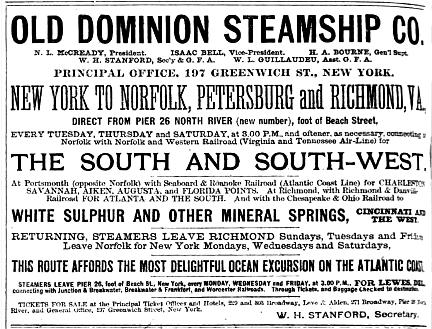
XXX |
|
Isaac Bell, who had been head of the Havre packet line, was vice president of the Old Dominion Steamship Co., as noted in the second line (under "O" and "N" in "Dominion") of this ad in the July 1881 issue of a travelers guide published under auspices of the National Association of General Passenger and Ticket Agents. Click image to access source page. Use browser's "back" button to return here.
| | Isaac Bell was the Robert Moses of his era, wearing more hats of public office and moving more levers of public authority than a half dozen other pols combined.
Over a lengthy span of years, he was an active member of the Board of Supervisors, Board of Education, Board of Emigration, and Board of Public Charities and Correction, plus an officer in several business associations and philanthropic institutions, all virtually at the same time.
One example of his influence: Bell brought together in his home a group of men who believed there should be a female equivalent to the then all-male City College. They formed a committee, elected him their committee chairman and named educator Thomas Hunter as president of the women teachers training school they were launching. The year was 1869. In time, the institution became Hunter College, now part of CUNY.
|
XXX
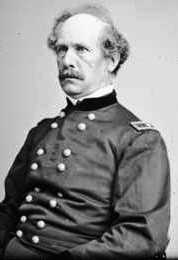
XXX |
|
As president of the Metropolitan Police Board, James Bowen helped organize a number of Metro Police volunteer regiments, some units of which trained on Rikers and Hart Islands, not then part of the Public Charities & Correction domain. He also served during the war as Army provost in the Gulf region. Clicking the above image accesses the very interesting Antique Reprint website page featuring Library of Congress Civil War photos. Use your browser's "back" button to return here.
| | James B. Nicholson had served with Bell both on the Board of Emigration and on the ruling body at Tammany Hall. Both were Sachems (top leaders) in it. Nicholson, as Grand Sachem with Bell's support, would later preside over the expulsion of Boss Tweed from the organization.
- James Bowen, born to wealth, had no financial need nor passionate interest in business affairs but devoted himself primarily to public service.
Nevertheless, with his estate being located in Hastings-on-Hudson, he found myself commuting by railroad between his home and NYC.
In due course, he developed an interest in rail transport, acquired rail shares and became president of Erie RR.
When the Legislature created the Metropolitan Police force to cover New York, Kings, Richmond and Westchester Counties, Bowen was one of five commissioners appointed to run it.
They elected him Metropolitan Police board president.
In that position, he had to face off against Mayor Fernando Wood, who refused to recognize the legitimacy of the "Metros" as they were called.
Bowen would not back down. He persevered despite Wood's resistance in court and in the streets where, at various times during 1857, pitched battles took place between the Metropolitans and Wood's Municipals in alliance with gangs from the Bowery and Five Points districts.
The Metros eventually prevailed for about a decade and a half. Their doing so impacted history. Arguably Lincoln might not have been elected if Wood and his police force had overseen NYC voting the 1860 election.
The NYC Democratic machine had been perceived by the NYS Legislature's Republican majority as having controlled and manipulated the NYC vote and tally in 1856, costing GOP Presidential candidate John C. Fremont the election. That led the Legislature to create the Metro Police force.
|
XXX
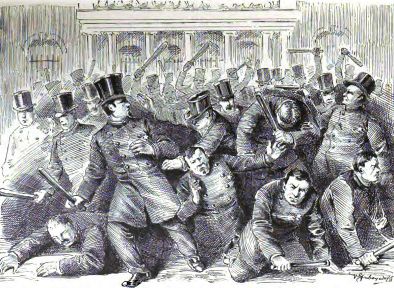
XXX |
|
The above image is from an illustration depicting the 1857 battle between police forces -- 50 Metropolitans vs. 500+ Municipals -- on the steps of City Hall when Mayor Fernando Wood refused to submit to court processes. The Metros police board, which was headed by retired Brig. Gen. Bowen, called upon the just then passing-in-parade 7th Army Regiment for assistance. The federal troops marched in formation to City Hall, at which point Woods realized he had to accept the court order of his arrest and did so. The illustration appears in the book Recollections of a New York Chief of Police by George Washington Walling who was its uniformed leader. Click image to access. Use your browser's "back" button to return here.
| | When the Southern states sought to secede, Bowen helped the formation of Union regiments by Metro volunteers. More than a half dozen such Metro units trained on Rikers and Hart Islands before shipping out to the battlefronts. Bowen himself served as a colonel and later as Army Provost of the entire Gulf region.
Once back in NYC, Brig. Gen. Bowen had a large following of current and former police and Army colleagues ready, if called upon, to enlist in causes he might undertake. He inspired that kind of loyalty.
- Owen W. Brennan owed much of his political leverage to the fact that his brother was Matthew T. Brennan, former City Controller and Tammany Sachem who became a Police Commissioner in 1868 and Sheriff in 1870.
But Owen also had his own circle of influence as a Republican. Young Brennan had been an organizer of "Unionists," former Democrats who supported Whig Presidential candidate Gen. Winfield Scott in the 1852 election. After the Millard Fillmore Presidency, many Whigs opposed to slavery expansion -- such as Lincoln -- migrated to the Republican Party. So did many "Unionists," including Brennan.
Owen was a delegate at the 1858 GOP state convention that nominated Edwin Denison Morgan for Governor and at the party's 1860 state convention that backed former Gov. William H. Seward for the Republican Presidential nomination which ultimately went to Lincoln.
|
XXX
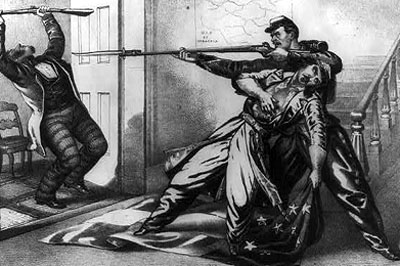
XXX |
|
The above image -- depicting the mortally wounded Elmer E. Ellsworth and the slaying of his killer -- is in the Library of Congress collection of Civil War prints. Click the image to access the very excellent website of the 5th Regiment, New York State Volunteers Duryee Zouaves with extensive information about Ellsworth and his NY Fire Zouaves. Owen W. Brennan, a leader in NYC volunteer firemen circles, helped to reorganize them to continue fighting for the Union cause -- in Ellsworth's name. Use your browser's "back" button to return here.
| | Brennan, long active in NYC "fire vol" affairs, was elected in February of 1862 to chair a meeting to re-organize the Fire Zouaves to continue the fight for the Union, in the name of Colonel Elmer E. Ellsworth, close friend of Lincoln. Organizer of the New York Fire Zouaves, Ellsworth was widely credited as being the first Union officer fatality of the Civil War.
Like Bowen, Brennan took an interest in rails but on a much smaller scale -- surface railroading; that is, a trolley line. He was one of the 13 directors of the Central Park, North and East Rivers Railroad. Tweed was another.
Clearly, if the Commissioners teamed up on a project each cared about personally, these four men collectively had the political muscle, connections and skills to jump their agency ahead of organizations -- namely, the Chamber, the school board, and the House of Refuge -- who had earlier starts for the same prize. That's what happened. The prize project: launching NYS & NYC's first maritime training ship.
PC&C Was the Superagency of Its Time
Another factor to keep in mind in understanding how Public Charities and Correction (PC&C) moved so quickly to the head of the line was its own power as a superagency.
Think of today's Health, Hospitals, Human Services, Jobless Centers, Mental Health Services, Jails, Prisons, Juvenile Detention, Child Protection Services, Senior Citizen Centers, Nursing Homes, Homeless Shelters, Welfare Relief and a few other modern urban government services all rolled into one humongous municipal department. That was PC&C. Its domain was huge.
|
XXX
PC&C's EAST RIVER 'FLEET'
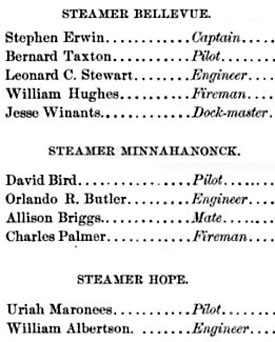
XXX
|
|
The above image is extracted from the 1869 Manual of the corporation of the city of New York list of PC&C's East River boats and crews that transported passengers and materials between the various islands which had the agency's facilities: Randall's, Ward's, Blackwell's, Manhattan and Hart.
According to the PC&C Commissioners' 1869 minutes, Captain S. Erwin was put in charge of all steamers of the agency, "to keep them in order and ready for service at all times," and his salary was increased to $1,500 to reflect "his increased duties." Click image to access 1869 city manual.
Use browser's "back" button to return here.
| |
The total admissions into PC&C's 18 institutions (counting all its City Prisons as one) during 1868 numbered 92,272 (with the correctional facilities getting about half of those) and its expenses totaled $942,891.
PC&C's 1868 report also listed its largest expense item as $243,352 for salaries; the next largest being $111,149 for fresh (unsalted) beef.
To place those figures into perspective, consider that the Blackwell's Island penitentiary payroll list in the 1868 annual report showed individual salaries of about two dozen keepers ran $900 each.
Warden John Fitch made twice that but the amount included $50 for the "keep of cow." Five "guards" were paid $480 each.
Theodore S. Shadbolt was listed with the "guards" but identified as "Ex-keeper (blind)" and paid $500. A March 19, 1856 NYT item reporting on a meeting of the PC&C's ancestor agency, the Board of Almshouse Governors, referred to "old keeper and bell-ringer Shadbolt who, though not absolutely blind, lost his sight in service of the Board from an accident." He was voted $500 per annum instead of the usual $350.
The 1868 report listed Matron Ella H. Halliwell as being paid $500 plus $109 for "Board."
Given that the agency's operations, employing hundreds and impacting tens of thousands, reached into every district of the city, the lawmakers in City Hall and the Albany State House from those districts were acutely aware of the power wielded by the four Commissioners to whom they might in some not too distant future have to go for a favor or accommodation on behalf of a valued constituent or special project.
In addition to the personal political influence they brought with them to their posts as PC&C Commissioners, their board -- in accordance with the law establishing it -- possessed extraordinarily sweeping discretionary executive powers over its institutions and over the inmates and patients lodged in them. It was micro as well as macro management.
|

